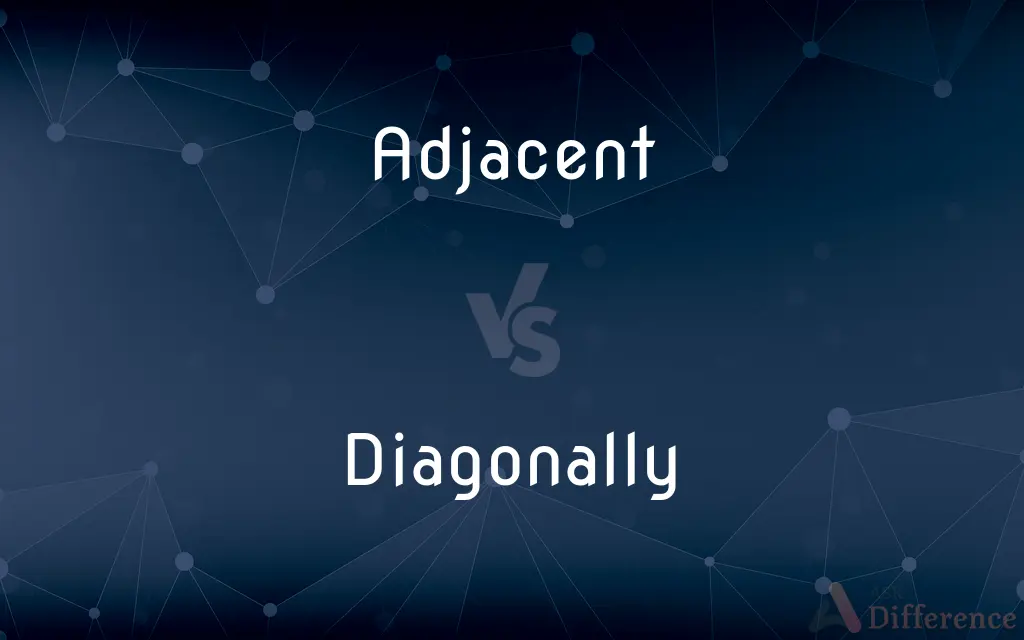Adjacent vs. Diagonally — What's the Difference?
By Tayyaba Rehman & Urooj Arif — Updated on April 18, 2024
Adjacent refers to being next to or adjoining something else; diagonally implies an angle or movement across a space from one corner to another.

Difference Between Adjacent and Diagonally
Table of Contents
ADVERTISEMENT
Key Differences
Adjacent refers to something being immediately next to or very close to another object or element, often touching or sharing a boundary. On the other hand, diagonally describes a direction or position that cuts across a space from one corner to another, typically forming a straight line that connects opposite corners.
While adjacent items are directly next to each other without any intervening space, diagonally positioned items are not directly next to each other but are connected through a sloped line that passes through the intervening space.
Adjacent positioning implies a relationship of proximity that facilitates direct interaction or connectivity, such as two adjacent seats or houses. Conversely, diagonally implies a more distant and indirect connection, like seats in a theater or positions on a chessboard that are diagonally opposed.
In geometry, adjacent often relates to angles or sides that share a common vertex or edge. Diagonally, however, is used to describe lines or measurements that span across the figure, connecting non-adjacent corners or ends.
Adjacent is commonly used in everyday contexts to describe physical closeness, such as adjacent parking spaces. Diagonally, however, often appears in more technical or specific contexts like in games, mathematics, or describing seating arrangements.
ADVERTISEMENT
Comparison Chart
Relation
Directly next to each other
Connects across at an angle
Position
Side by side, touching
Across, typically not touching
Common Usage
Buildings, rooms, objects
Movement, positioning, measurements
Geometric Usage
Shared edges or vertices
Connecting opposite corners
Example Context
Adjacent hotel rooms
Diagonally opposite seats
Compare with Definitions
Adjacent
Being in contact at a single point or along a border.
The adjacent teeth must be treated as well.
Diagonally
From one corner to another, typically across a square or rectangle.
The road cuts diagonally across the field.
Adjacent
Next to or adjoining something else.
The library is adjacent to the school.
Diagonally
Connecting non-adjacent corners or points.
The bishop moves diagonally across the board.
Adjacent
Sharing a common boundary.
Their farm and our property are adjacent.
Diagonally
Not directly opposite but between positions.
The light came from a window placed diagonally from us.
Adjacent
Immediately next to.
She sat in the chair adjacent to mine.
Diagonally
In a slanted or oblique direction.
He moved diagonally to intercept the pass.
Adjacent
Close or near, without intervening space.
The adjacent rooms share a wall.
Diagonally
Used to describe an indirect path or alignment.
She painted the stripes diagonally for visual effect.
Adjacent
Next to or adjoining something else
Adjacent rooms
The area adjacent to the station
Diagonally
Joining two nonadjacent vertices of a polygon.
Adjacent
(of a pair of angles) formed on the same side of a straight line when intersected by another line.
Diagonally
Joining two vertices of a polyhedron not in the same face.
Adjacent
Close to; lying near
Adjacent cities.
Diagonally
Having a slanted or oblique direction.
Adjacent
Next to; adjoining
Adjacent garden plots.
Diagonally
Having oblique lines or markings.
Adjacent
Lying next to, close, or contiguous; neighboring; bordering on.
Because the conference room is filled, we will have our meeting in the adjacent room.
Diagonally
Relating to or being the front left and back right feet or the front right and back left feet of a quadruped.
Adjacent
Just before, after, or facing.
The picture is on the adjacent page.
Diagonally
(Mathematics)A diagonal line or plane.
Adjacent
Related to; suggestive of; bordering on.
Diagonally
Something, such as a row, course, or part, that is arranged obliquely.
Adjacent
Something that lies next to something else, especially the side of a right triangle that is neither the hypotenuse nor the opposite.
Diagonally
A fabric woven with diagonal lines.
Adjacent
Next to; beside.
The house adjacent to the school was demolished.
A notice was sent to the house adjacent the school.
Diagonally
A virgule.
Adjacent
(figuratively) Related to; suggestive of; bordering on.
Diagonally
In a diagonal manner, not square to any direction.
Adjacent
Lying near, close, or contiguous; neighboring; bordering on; as, a field adjacent to the highway.
I find that all Europe with her adjacent isles is peopled with Christians.
Diagonally
In a diagonal direction.
Adjacent
That which is adjacent.
Diagonally
In a diagonal manner;
She lives diagonally across the street from us
Adjacent
Nearest in space or position; immediately adjoining without intervening space;
Had adjacent rooms
In the next room
The person sitting next to me
Our rooms were side by side
Adjacent
Having a common boundary or edge; touching;
Abutting lots
Adjoining rooms
Rhode Island has two bordering states; Massachusetts and Conncecticut
The side of Germany conterminous with France
Utah and the contiguous state of Idaho
Neighboring cities
Adjacent
Near or close to but not necessarily touching;
Lands adjacent to the mountains
New York and adjacent cities
Common Curiosities
Can two rooms be both adjacent and diagonally aligned?
Typically, rooms that are adjacent are directly next to each other, not diagonally. Diagonal alignment would imply a different geometric arrangement.
What does it mean when two objects are adjacent?
When two objects are adjacent, they are directly next to each other, often touching or very close.
How do objects relate when positioned diagonally?
Objects positioned diagonally are connected by a line that crosses the space between them, usually at an angle.
What does it mean for properties to be adjacent?
Properties that are adjacent share a common boundary or border, like adjacent lots in a subdivision.
How is diagonal movement used in games?
In games like chess, diagonal movement allows pieces like bishops to move across the board, connecting opposite corners.
Do adjacent objects always touch each other?
Adjacent objects often touch but may also just be extremely close without actual contact.
What is an example of adjacent angles?
Adjacent angles share a common vertex and edge, like the two angles along a straight line.
Can you be diagonally across from someone in a room?
Yes, if you are positioned at one corner and another person is at the opposite corner, you are diagonally across from them.
Is diagonally a common term in daily conversation?
Diagonally is less common in daily speech unless discussing directions, positions, or specific contexts like fabric patterns.
What is a diagonal line in geometry?
A diagonal line in geometry connects two non-adjacent vertices or corners of a polygon.
Share Your Discovery

Previous Comparison
Dazzle vs. Sparkle
Next Comparison
Democracy vs. TotalitarianismAuthor Spotlight
Written by
Tayyaba RehmanTayyaba Rehman is a distinguished writer, currently serving as a primary contributor to askdifference.com. As a researcher in semantics and etymology, Tayyaba's passion for the complexity of languages and their distinctions has found a perfect home on the platform. Tayyaba delves into the intricacies of language, distinguishing between commonly confused words and phrases, thereby providing clarity for readers worldwide.
Co-written by
Urooj ArifUrooj is a skilled content writer at Ask Difference, known for her exceptional ability to simplify complex topics into engaging and informative content. With a passion for research and a flair for clear, concise writing, she consistently delivers articles that resonate with our diverse audience.














































